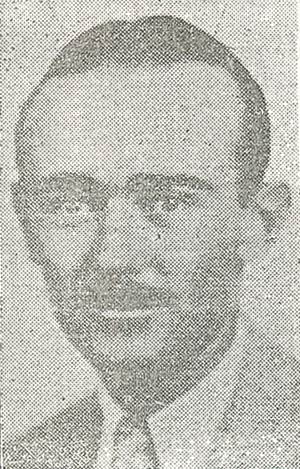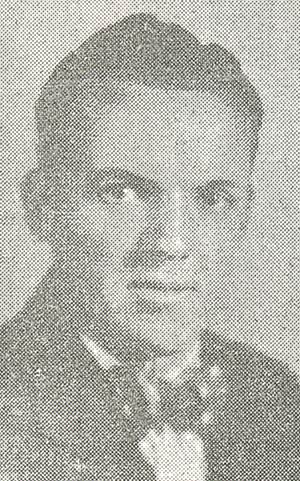|
PLEASE NOTE: Besides this biographical page, an extensive
collection of images taken and owned by C.B. Cosgrove, Jr.
is available for your view on this website at this link:
THE
CORNELIUS BURTON COSGROVE, JR. PHOTOGRAPH AND DOCUMENT
COLLECTION
The information that follows was acquired during
my meeting with Cosgrove's son, C.B. Cosgrove, III during October
2006. For no other pilot of the Davis-Monthan Register do
we see such complete life images and career documentation
as we do for pilot Cosgrove. Thanks to
C.B. Cosgrove, III for sharing these intimate views of his
father's life.
We should be alert, however, to the fact that
ALL Register pilots and passengers probably had equally
interesting lives. If you are reading this and have information
relevant to any of them, please let me know.
Below, C.B. Cosgrove,
Jr. at age 2. His biography continues following the
image.
Cornelius Burton Cosgrove, Jr. 1908, age 2
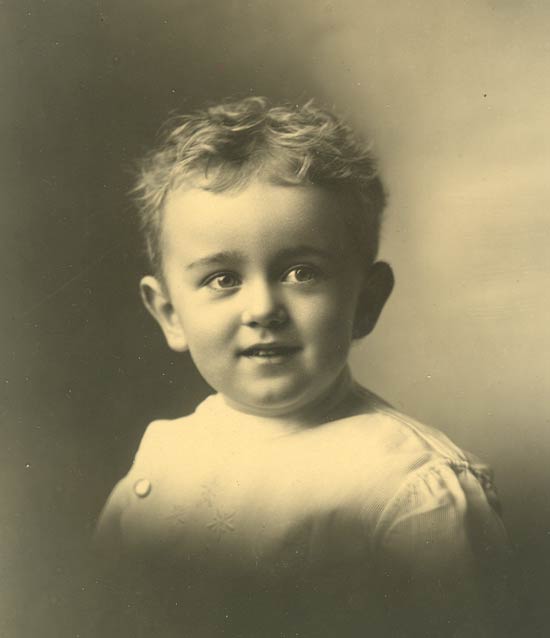 |
During my visit his son shared the
following biographical eulogy, written by him on the occasion
of his father's death at age 93. I have added links to relevant
news articles which were also shared with us by Burt, III.
"C.B. 'Burt' Cosgrove
8 February 1906 - 7 August 1999
C.B. Cosgrove, Jr. ca. 1928
 |
"Col. C.B. 'Burt' Cosgrove, a member of a pioneer
New Mexico family and one of the state's first aviators died
Saturday, August 7. He was 93. Cosgrove made his first solo
flight at the age of 15 in a Curtiss 'Jenny' (JN-4D) bi-plane
that he had assembled himself. While still in his early twenties,
he went on to become the first director of the Tucson airport,
where he worked with Col. Charles Lindbergh setting up the
nation's first transcontinental airline route. After beginning
active duty with the U.S. Air Corps in the mid-1930's, Cosgrove
piloted the the experimental B-17 bomber and worked with
General 'Gene' Eubank to organize the famed 19th Bombardment
Group which trained at Albuquerque's Kirtland Field.
"In 1941 he helped set up a bomber squadron
to protect the American Commonwealth of the Philippines and
was at Clark Field when it was bombed on Pearl Harbor Day.
in the early years of World War II Colonel Cosgrove flew
bombing missions in the Pacific. When the Philippines were
occupied by the Japanese, he and General Eubank and other
key officers were ordered to evacuate. After his plane was
destroyed, he fought his way overland through jungle terrain
and enemy-controlled sea-lanes eventually making his way
to safety in Australia. In recognition of his leadership
in combat Colonel Cosgrove was awarded the Silver Star, one
of the nation's highest military decorations.
C.B. Cosgrove, Jr. ca. 1933
 |
"Burt Cosgrove was born in 1906 in Atchison,
Kansas, where perhaps, prophetically, the Cosgroves were
neighbors to the family of pilot Amelia Earhart. In 1907
Cosgrove Sr. moved with his wife and year-old son to New
Mexico. They settled near relatives in Silver City. From
earliest childhood Burt worked alongside his parents, well-known
Southwest archaeologists Cornelius Burton Cosgrove and Harriet
'Hattie' Silliman Cosgrove, who -- in affiliation with the
Harvard University Peabody Museum -- supervised the excavation
of the historic Mimbres villages of southwestern New Mexico.
"Burt attended New Mexico Military Institute
and went on to the University of Arizona where he received
a degree in archaeology. Cosgrove supervised significant
projects at Casa Grande National Monument and the Petrified
Forest in Arizona before giving up an already notable career
in archaeology to pursue his love of flying. In 1931 he married
Mildred Barbara Tuthill [PDF
download 7.54MB] who became a pilot. Lifelong international
travelers, the couple spent the first year of their married
life in Peking, where Mildred is believed to have been the
first woman
pilot to fly in China [PDF downlad 3.6MB].
"After the evacuation of the Philippines,
Colonel Cosgrove was stationed at the Pentagon in Washington,
DC, where he helped recruit many of the scientists and military
officers who worked on the atomic bomb project. At war's
end, he served as commander of the Santa Monica Air Force
Redistribution Center under the direct command of General
'Hap' Arnold, chief
of staff of the U.S. Air Force, and later served on
C.B. Cosgrove, Jr. ca. 1948
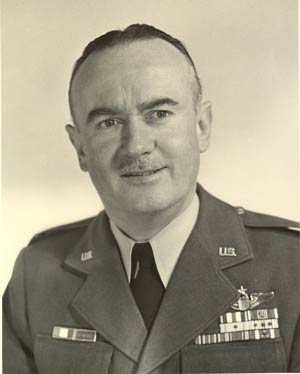 |
the Inspector General's staff overseeing reconstruction
of much of war-ravaged Europe.
"Cosgrove throughout his career was associated
with movie projects, which began with his role taxiing planes
in California for Howard Hughes' film 'Hell's Angels'. He
later flew a B-17 bomber that was featured in the 1941 movie
'They Wanted Wings'. In the late 1940s Colonel Cosgrove was
base commander at Burbank Field where he produced training
films for the Air Force. Tyrone Power and Gary Cooper were
among the early film actors who worked with him and who remained
friends. The Cosgroves had one son, Burt III who accompanied
them on many of their world travels. Colonel Cosgrove continued
to fly up until the time of his retirement in 1956.
"After retirement, the Cosgroves settled in
Albuquerque. New Mexico had been a family home since the
mid-nineteenth century. Colonel Cosgrove continued to travel
throughout his retirement years, returning to China, and
traveling to Tibet in 1983 where he had not been allowed
access on his first visit to China in 1931. Colonel Cosgrove
is survived by his son, retired Judge Burt Cosgrove."
C.B. Cosgrove, Jr. age 90
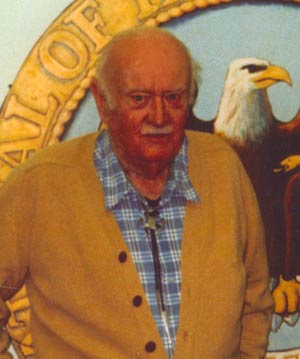 |
Cosgrove's tenure as manager of the Davis-Monthan Airfield
lasted from 1928 to 1932. Budget and other issues early in
the Great Depression had him leave and come back to his position.
This series of news
articles (PDF download 10.5MB) summarizes some of the
issues (NOTE WELL: the journalism of the era was less politically
correct than it is today, and you will find racial references
in two of these articles that wouldn't appear nowadays).
Image, right, of two mature eagles.
Probably the most frightful
flight of Cosgrove's life came late in his military career.
The was tasked in the mid-1950s with flying a photographer
over the Grand Canyon in a DC-3. The photographer, not satisfied
with taking pictures through the windows, without thinking
opened the side door.
The slip stream ripped the door from the fuselage and it
proceeded aft to impact the left horizontal stabilizer and
wrap itself firmly around it.
The horizontal stabilizer held! But, the flight and trim
characteristics of the DC-3 must have been dreadful with
the drag and disruption of airflow caused by the cargo door.
Cargo Door Where It's Not Supposed to Be!
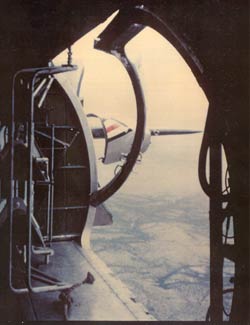 |
The flight was aborted and the airplane and crew made it
safely to an emergency landing. The spectacular image, left,
shows the door firmly bent around the horizontal stabilizer,
and the door frame out in the slip stream. Note that the
airplane is aloft and well under control.
We wonder how fatigued Cosgrove's right
leg was as he landed after fighting what was probably considerable
left yaw. Surely this was an exercise in emergency trimming
and differential engine control as well.
The good news is, the photographer
had the presence of mind to snap this picture. The bad news
is, his mind was less present in considering the effect
of opening a door into what is the equivalent of a Category
5 hurricane streaming along the fuselage of a DC-3.
Although there was no mention as to the fate
of the photographer, he probably received some extra "training"
when he reported for duty the next day.
Aftermath!
 |
Image, right, shows Cosgrove examining the aftermath of
the cargo door striking the horizontal stabilizer. This picture
gives testimony to the strength of the Douglas DC-3 design!
Notice that this is probably a "posed" photo-op, because
the door is placed over the stabilizer opposite to the position
it is in the image above during flight.
Image, below, of C.B. Cosgrove in 1999 shortly before his
passing.
C.B. Cosgrove, Jr. age 93
 |
Below is the original biography I developed for
Cosgrove based upon newspaper accounts from the Airzona Historical
Society. Please refer to it for details of the aircraft Cosgrove
flew to Tucson.
Indeed, his story has grown with the help
of his son. We know him better now. Thanks, Burt!
---o0o---
What follows is the original biographical
information first placed online on 01/12/06.
C.B. Cosgrove was a young entrepreneur. The Tucson
Star of July 29, 1928 carries an article describing his formation,
with partner H.W. Durham, of the Southwest Air Service, Inc.
The Service was planned to open at the Davis-Monthan Airfield
by September 1 that year. Incorporation papers for the Service
were filed just a week earlier on July 21 in Phoenix.
The Tucson Star states, "The officers of the air corporation
are C.B. Cosgrove [image, right, from the Star] and H.W. Durham,
both former university students and residents of the city.
The service is incorporated to "carry on the business
of transportation by air of passengers, express, freight,
mail and every kind of commodities," as well as to maintain
a school and give flying instructions.
"Cosgrove, who is a member of the chamber of commerce
aviation committee, is a licensed pilot, having passed his
tests about nine months ago. He has been associated with flying
for six years. His last job was pilot a Ryan Field, San Diego,
California.
"The equipment of the service will include a hangar
on the field, three air-cooled Seimens-Halske Travelair [sic]
planes for student instruction, delivery of which should
be made September 1; one whirlwind Travelair [sic] which
will be brought to Tucson the middle of next month from the
factory by Cosgrove and one OK Travelair [sic] plane which
the service already has on hand. The service will also be
the agency for Travelair in Arizona and New Mexico."
The "OK" Travel Air mentioned by the Star should
read "OX". It was probably Travel Air
NC4533 purchased the previous March by Cosgrove. It had
a 90 HP Curtiss OX-5 engine. See the link for that aircraft's
history. Cosgrove and Durham landed twice at Tucson in this
airplane: June 11 and 25, 1928.
The Star goes on to say, "The service is incorporated
for $150,000 with 6,000 shares of stock. Both of the incorporators,
Cosgrove and Durham [image, left from the Star] are 23 years
old, both university students (class of 1928). Although Durham
has not received his license, he expects to pass his tests
within a short time." Durham does not show up among the
list of pilots who landed at Davis-Monthan. I do not know
if he ever acquired his flying credentials.
Cosgrove flew two other airplanes to Tucson. He landed solo
on October 26, 1928 flying Curtiss 6661. He signed the Register
as "Bert" Cosgrove on that occasion. On April
1, 1929 he landed flying Travel Air NC6455. He carried
passenger E. Bennett, arriving from Hurley, NM. Cosgrove
also landed as a passenger on 9/24/1929 with pilot E.B.
Christopher. He also landed as a passenger in Boeing
40, NC381 on December 12, 1929.
I couldn't find anything on Cosgrove or Durham later in their
lives. This passage from the Whitcomb reference, left, mentions
Cosgrove, but misspells his name as "Bert."
| "On one occasion when his plane was high over
the western Pacific, Saint Elmo’s fire enveloped
his aircraft. That is a condition when a fiery glow
develops over the exterior of the plane while in flight.
It is temporary and not dangerous. Being unfamiliar
with it, Berkowitz became alarmed. It alarmed Berkowitz
until his pilot, Col Bert [sic] Cosgrove, explained
the phenomenon to him." |
---o0o---
Dossier: 2.1.77
THIS PAGE UPLOADED: 01/12/06 REVISED: 03/22/06 11/19/06
|










